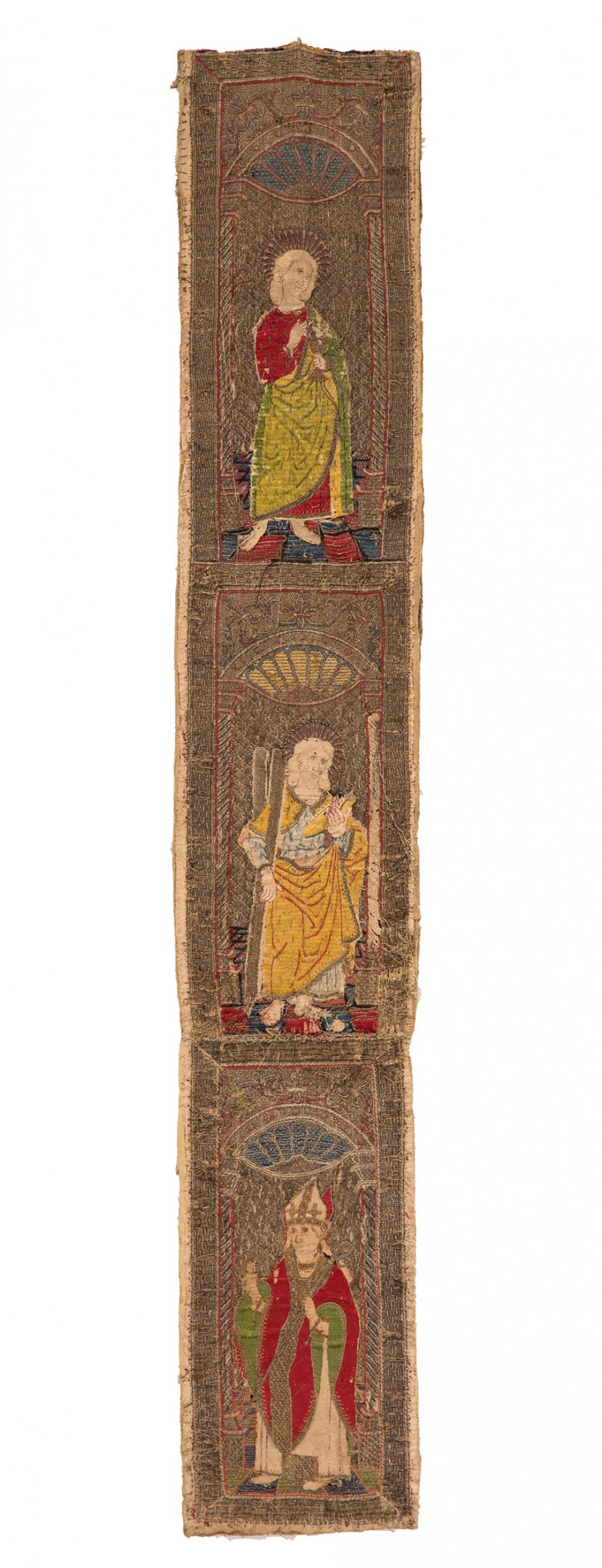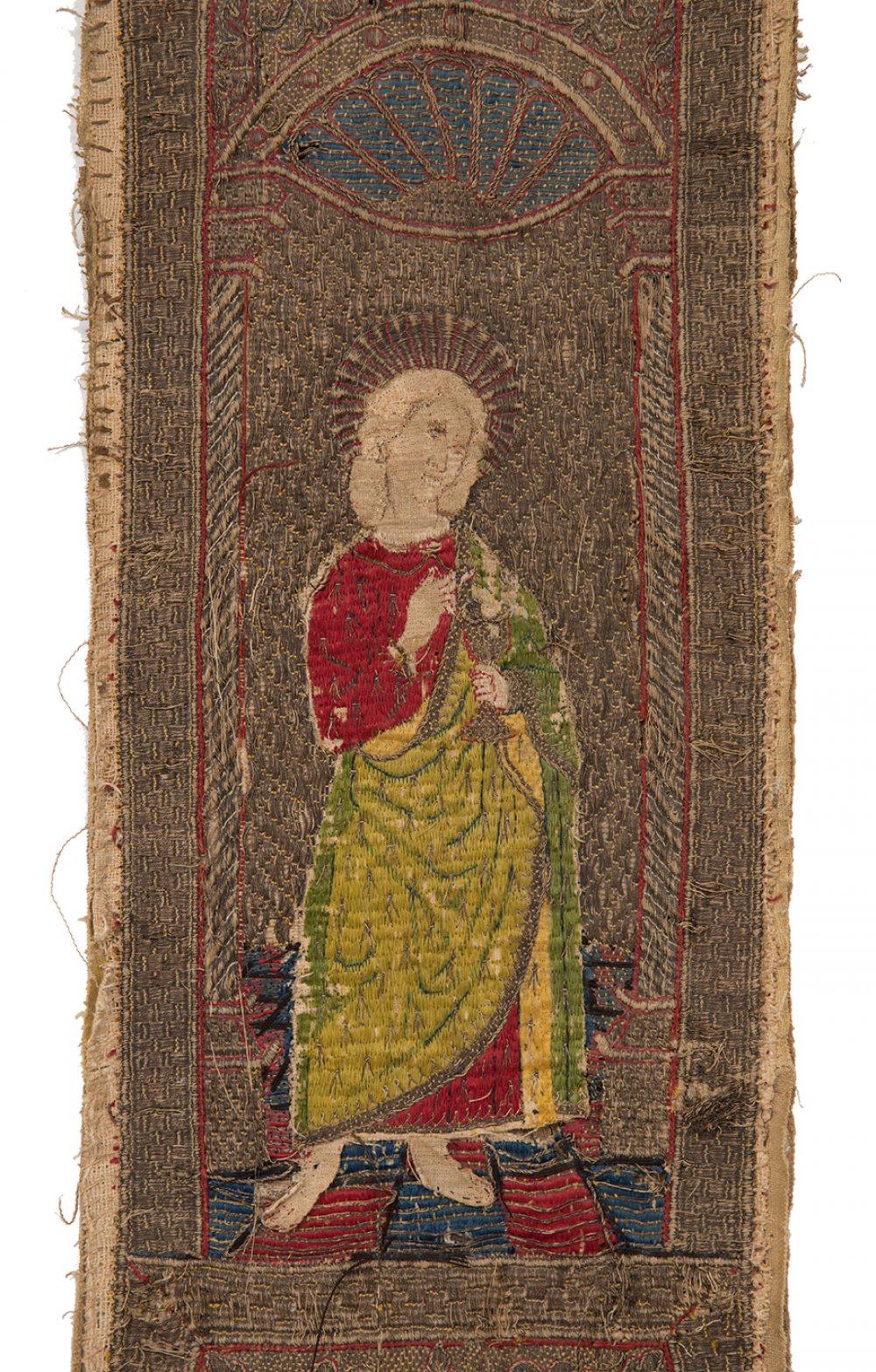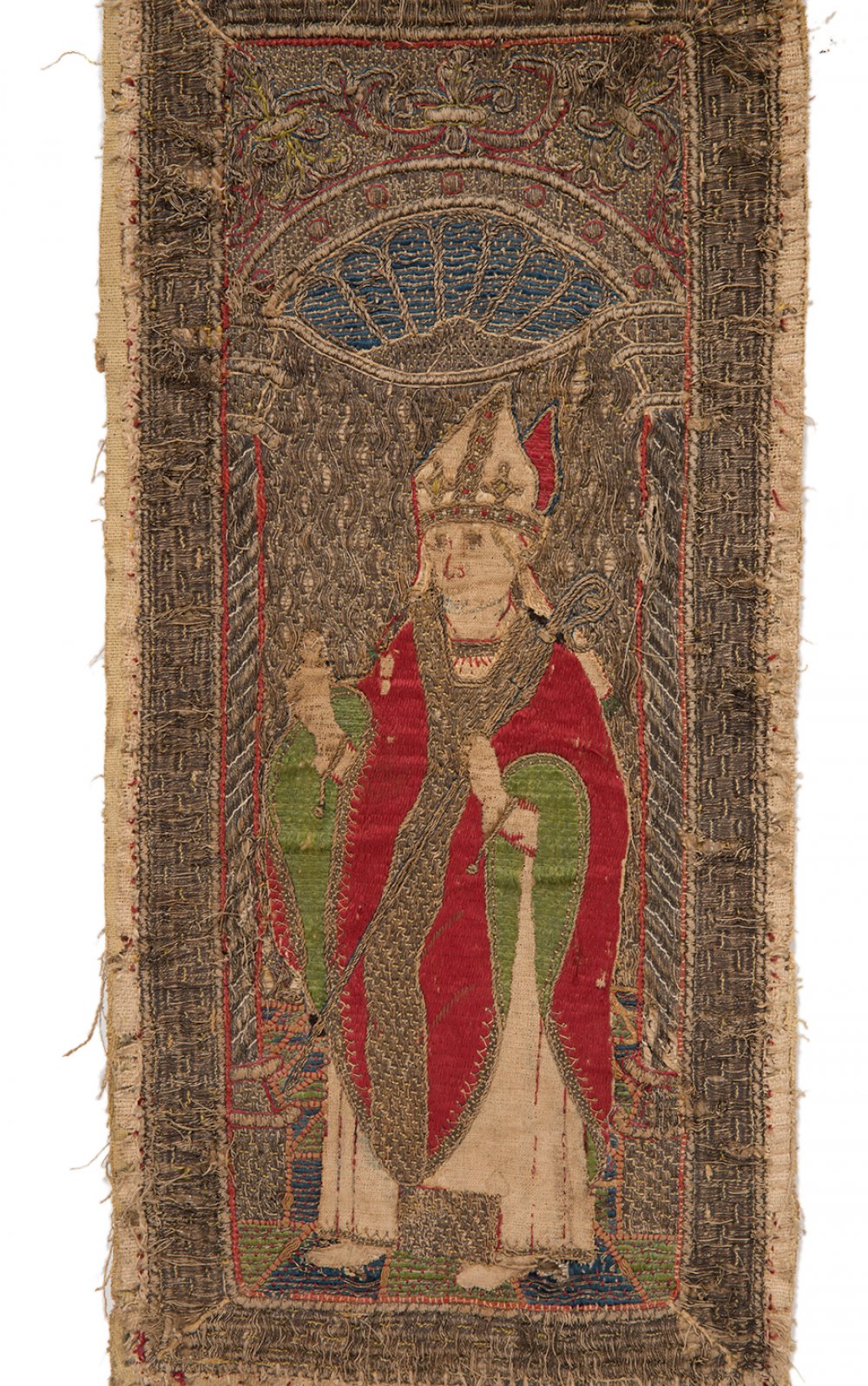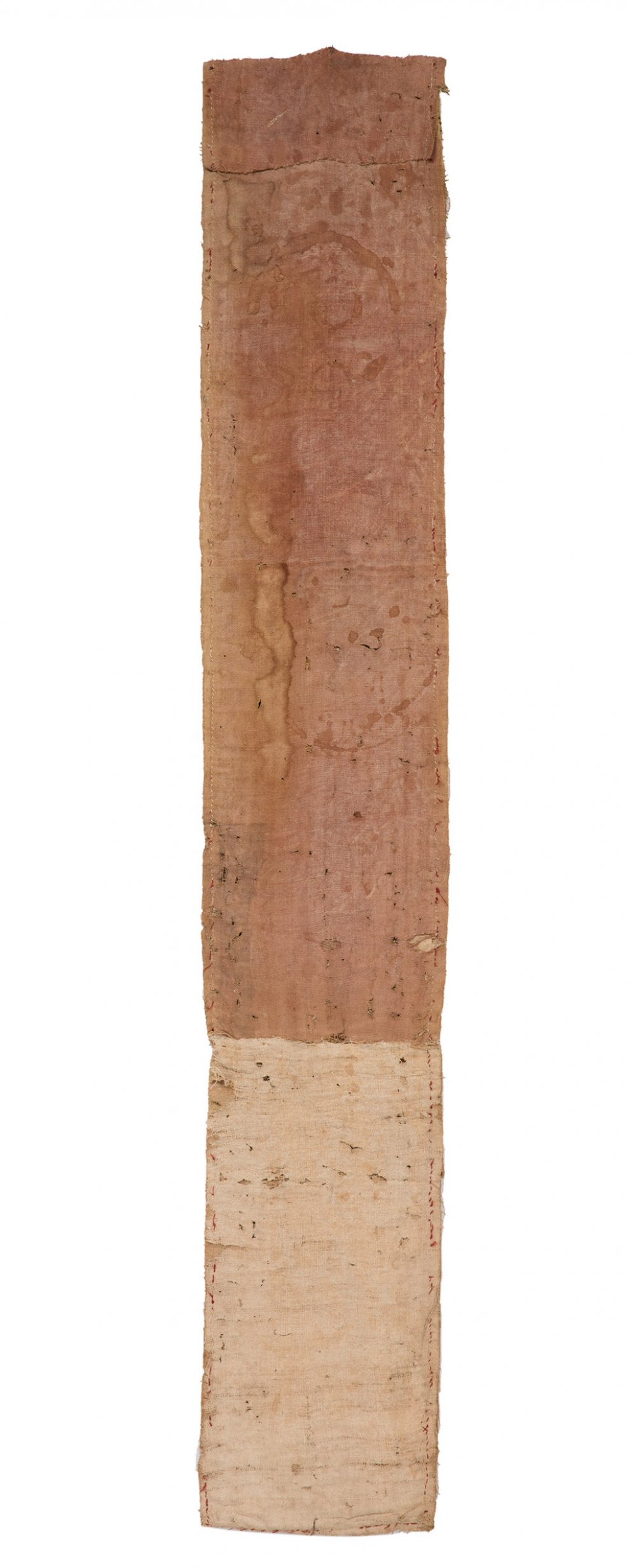23
Renaissance embroidery; Spain, first half of the 16th century."Saint John, Saint Andrew and Saint
"Saint John, Saint Andrew and Saint Augustine".
Damage and losses.
Measurements: 135 x 22 cm.
The creation of embroidery has always been an art associated with femininity, the work of nuns, these pieces of exceptional technique used as ornamentation have been valued and revalued in recent decades. This piece depicts three saints: St. John, St. Andrew and St. Augustine. The Gospels say that John the Baptist was the son of the priest Zechariah and Elizabeth, cousin of the Virgin Mary. He retired at a very young age to the desert of Judea to lead an ascetic life and preach penance, and recognised in Jesus, who was baptised by him, the Messiah announced by the prophets. A year after Christ's baptism, in the year 29, John was arrested and imprisoned by the tetrarch of Galilee, Herod Antias, whose marriage to Herodias, his niece and sister-in-law, he had dared to censure. Finally, St. John was beheaded, and his head given to Salome as a reward for his beautiful dances. This saint appears in Christian art in two different guises: as a child, a playmate of Jesus, and as an adult, an ascetic preacher. The adult Saint John depicted here is dressed in Eastern art in a camel-skin sackcloth, which in the West was replaced by a sheepskin that leaves his arms, legs and part of his torso bare. The red cloak he wears at times, as well as in the scene of his intercession at the Last Judgement, alludes to his martyrdom. In Byzantine art he is depicted as a large-winged angel, with his severed head on a tray held in his hands. However, his attributes in Western art are very different. The most frequent is a lamb, which alludes to Jesus Christ, and he often carries a cross of reeds with a phylactery with the inscription "Ecce Agnus Dei".
Aan Andrew is presented with the attribute of his martyrdom, the cross in the form of a cross on which he was tied by order of the proconsul Aegeas. The luminosity of the work, the predominance of blue tones and the peace that emanates from the bearded face, with its soft meditative features, form a peaceful image that shows us a saint who has already overcome pain and rests eternally beyond sacrifice. Andrew was the first apostle called by Jesus, which is why he was called by the Greeks Protokletos, "the first called". Brother of Simon Peter and, like him, a fisherman from Galilee, his name is Greek and not Hebrew, and means virile. He is mentioned twice in the Gospels: in connection with the vocations of the first two apostles, and in the episode of the multiplication of the loaves and fishes. His legend comes from the Apocryphal Acts, according to which he was appointed, after the death of Jesus, to evangelise Scythia, i.e. modern-day Russia. While preaching there, an angel appeared to him and said "Go to Matthew"; he was then miraculously guided to Ethiopia, where St Matthew had been blinded and imprisoned. The prison doors opened before Andrew, and he began to pray in front of Matthew, after which the prisoner regained his sight. His mission accomplished, he went to Greece and then to Asia Minor, where he reportedly performed a series of miracles. He finally met his death at Patras in the Peloponnese, where the proconsul Aegeas had him flogged with rods for preaching disobedience to the emperor, and then ordered him to be tied with ropes to a cross in the shape of an "X", where he died on the third day. The most popular attribute of Saint Andrew is precisely this cross, although until the 15th century he is most often depicted crucified on a normal cross.
St. Augustine of Hippo (Tagaste, 254, Hippo Reggius, 430) was a doctor of the Catholic Church, known, among other things and for his writings, for a legend: the saint is said to have walked along the seashore, thinking about the Trinity.
"Saint John, Saint Andrew and Saint Augustine".
Damage and losses.
Measurements: 135 x 22 cm.
The creation of embroidery has always been an art associated with femininity, the work of nuns, these pieces of exceptional technique used as ornamentation have been valued and revalued in recent decades. This piece depicts three saints: St. John, St. Andrew and St. Augustine. The Gospels say that John the Baptist was the son of the priest Zechariah and Elizabeth, cousin of the Virgin Mary. He retired at a very young age to the desert of Judea to lead an ascetic life and preach penance, and recognised in Jesus, who was baptised by him, the Messiah announced by the prophets. A year after Christ's baptism, in the year 29, John was arrested and imprisoned by the tetrarch of Galilee, Herod Antias, whose marriage to Herodias, his niece and sister-in-law, he had dared to censure. Finally, St. John was beheaded, and his head given to Salome as a reward for his beautiful dances. This saint appears in Christian art in two different guises: as a child, a playmate of Jesus, and as an adult, an ascetic preacher. The adult Saint John depicted here is dressed in Eastern art in a camel-skin sackcloth, which in the West was replaced by a sheepskin that leaves his arms, legs and part of his torso bare. The red cloak he wears at times, as well as in the scene of his intercession at the Last Judgement, alludes to his martyrdom. In Byzantine art he is depicted as a large-winged angel, with his severed head on a tray held in his hands. However, his attributes in Western art are very different. The most frequent is a lamb, which alludes to Jesus Christ, and he often carries a cross of reeds with a phylactery with the inscription "Ecce Agnus Dei".
Aan Andrew is presented with the attribute of his martyrdom, the cross in the form of a cross on which he was tied by order of the proconsul Aegeas. The luminosity of the work, the predominance of blue tones and the peace that emanates from the bearded face, with its soft meditative features, form a peaceful image that shows us a saint who has already overcome pain and rests eternally beyond sacrifice. Andrew was the first apostle called by Jesus, which is why he was called by the Greeks Protokletos, "the first called". Brother of Simon Peter and, like him, a fisherman from Galilee, his name is Greek and not Hebrew, and means virile. He is mentioned twice in the Gospels: in connection with the vocations of the first two apostles, and in the episode of the multiplication of the loaves and fishes. His legend comes from the Apocryphal Acts, according to which he was appointed, after the death of Jesus, to evangelise Scythia, i.e. modern-day Russia. While preaching there, an angel appeared to him and said "Go to Matthew"; he was then miraculously guided to Ethiopia, where St Matthew had been blinded and imprisoned. The prison doors opened before Andrew, and he began to pray in front of Matthew, after which the prisoner regained his sight. His mission accomplished, he went to Greece and then to Asia Minor, where he reportedly performed a series of miracles. He finally met his death at Patras in the Peloponnese, where the proconsul Aegeas had him flogged with rods for preaching disobedience to the emperor, and then ordered him to be tied with ropes to a cross in the shape of an "X", where he died on the third day. The most popular attribute of Saint Andrew is precisely this cross, although until the 15th century he is most often depicted crucified on a normal cross.
St. Augustine of Hippo (Tagaste, 254, Hippo Reggius, 430) was a doctor of the Catholic Church, known, among other things and for his writings, for a legend: the saint is said to have walked along the seashore, thinking about the Trinity.
13th October - Old Masters
Sale Date(s)
Venue Address
General delivery information available from the auctioneer
Setdart offers Worldwide shipping
PICK UP IN ROOM: You can come and pick up your lots in our offices (Barcelona, Madrid or Valencia). At the moment of the withdrawal, you will be able to accept the current conditions of the lot by means of a document that you will sign.
YOU CAN SEND ANOTHER PERSON TO PICK UP: This person must present a signed authorization that you can find in our web page by accessing from BUY AT SETDART- LOGISTICS-DOWNLOAD AUTHORIZATION DOCUMENT. You can also send an e-mail with the requested data in AUTHORIZATION DOCUMENT to admin@setdart.com
Important Information
25% buyer´s premium
21% buyer´s premium at www.setdart.com
Terms & Conditions
The maximum period to pay the lots is 7 working days. You can pay either via bank transfer or with credit card through our platform www.setdart.com (we only accept VISA or Mastercard).
BUYER´S PREMIUM: 22% Hammer price + 21% VAT from the buyer´s premium
If your piece has more than 100 years, our Ministry of Culture requires an export certificate in order for the piece to leave the country. Note that if the piece goes inside the EU, there is no cost for the export certificate. If the piece goes outside the EU, there is a cost for the export certificate. You can find more information in our Ministry of Culture website: https://www.culturaydeporte.gob.es/en/cultura/patrimonio/exportacionimportacion/exportacion/tasas.html
INQUIRIES: admin@setdart.com
Setdart guides you through the entire process, from the time of award to the day you receive your lot. Our logistics team will be happy to manage your transport, and will advise you on the best shipping method with professionals from the sector used to handling works of art and jewelry.
WE OFFER WORLDWIDE DOOR TO DOOR SHIPPING
PICK UP IN ROOM: You can come and pick up your lots in our offices. At the moment of the withdrawal, you will be able to accept the current conditions of the lot by means of a document that you will sign.
YOU CAN SEND ANOTHER PERSON TO PICK UP: This person must present a signed authorization that you can find in our web page by accessing from BUY AT SETDART-LOGISTICS-DOWNLOAD AUTHORIZATION DOCUMENT. You can also send an e-mail with the requested data in AUTHORIZATION DOCUMENT to admin@setdart.com
SETDART IS NOT RESPONSIBLE FOR THE STATE OF THE PARTS ONCE THEY LEAVE OUR FACILITIES. MRW SHIPMENTS: Once the payment is made, your lot will be packed for shipment, the logistics department will send you an e-mail notifying you of the day it leaves our warehouse, changes of address cannot be made after receiving this e-mail.
INSURANCE INCIDENTS: Coverage for the value of the auction up to 3000 ? per shipment, if the value of the auction is higher, Setdart will send you a quote including the additional insurance. The insurance company WILL NOT BE RESPONSIBLE FOR THE SHIPMENT THAT EXCEEDS THAT AMOUNT AND IS NOT FULLY INSURED. MRW INCIDENTS: Maximum notification 48 hours after receipt, after which the insurance company WILL NOT BE RESPONSIBLE AND NO CLAIMS WILL BE ACCEPTED.
E-MAIL LOGISTICS: logistica@setdart.com
PICK UP YOUR MESSAGES: You can send your own messaging, prior notice via e-mail that your shipment is ready, please note 3 or 4 days in advance. This type of shipment is packaged so Setdart will provide you with a quote.
EXPENSES FOR STORAGE: We inform you that if the purchased lot is not picked up within a month, you will be charged 30€ per week per lot. Setdart Online S.L., owner of the web site "setdart.com", "setdart.net" and "setdart.org", acts as a company of Spanish nationality inscribed in the Volume 36955, sheet 182, page B-293056 of the Mercantile Registry, with registered office at Calle Aragó















